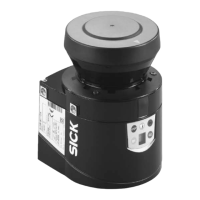
Do you have a question about the SICK S100 Standard and is the answer not in the manual?
| Number of Field Sets | 4 |
|---|---|
| Enclosure Rating | IP65 |
| Angular Resolution | 0.25° / 0.5° / 1° |
| Scanning Frequency | 25 Hz |
| Light Source | Infrared (905 nm) |
| Laser Class | Class 1 (IEC 60825-1) |
| Operating Temperature | -10°C to +50°C |
| Storage Temperature | -25°C to +70°C |
Covers essential safety precautions for device usage and installation.
Explains the purpose, target audience, and scope of the operating instructions.
Defines technical abbreviations and explains symbols used in the documentation.
Details proper device usage and qualifications required for personnel.
Outlines device applications, general safety measures, and environmental considerations.
Describes the physical components and key technical features of the S100.
Explains the operational principles and differences between S100 variants.
Details adjustable functions like switching fields, resolution, and monitoring cases.
Explains how LEDs and the 7-segment display indicate device status and errors.
Guidelines for defining switching field size based on vehicle dynamics.
Procedures and options for physically installing the S100 laser scanner.
Details the system plug, terminal connections, and pin assignments for the S100.
Covers cable gland usage, wire cross-sections, and pre-assembled plugs.
Illustrates a warehouse bay monitoring application with the S100 Standard.
Shows a distance monitoring application with the S100 Professional.
Describes the initial state and requirements for configuring the S100.
Details how to configure the CANopen interface and data transfer.
Steps and indicators for the first-time startup and configuration of the S100.
Guidance for re-installing or re-activating a previously commissioned S100.
Instructions for cleaning the optics cover and procedures for replacement.
Information on contacting SICK support and interpreting LED status and error messages.
Explains the meaning of 7-segment display codes for errors and operational status.
Describes how to use the CDS-S100 software for advanced troubleshooting.
Details object detection characteristics, remission levels, and scanning ranges.
Information on device response times, including the effect of multiple sampling.
Comprehensive technical data and physical dimensions of the S100 and mounting kits.
Lists S100 system part numbers, mounting kits, and spare parts.
Details system plug options, service cables, connection cables, and documentation.
Official declaration of the product's conformity with EC directives.
Definitions of technical terms used in the manual.
Indexes of tables and figures within the operating instructions.